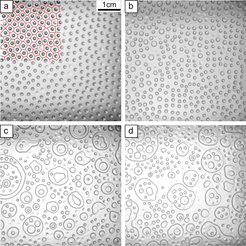Convection - Experiments
Two-phase convection
Leidenfrost pattern formation and boiling
Interesting Leidenfrost phenomena are observed in RBC-cells when the distance between the hot bottom and cold top plate is only 0.5 mm. Using only SF6 as the working fluid at conditions where the bottom plate is above and the top plate below the saturation temperature, the liquid drops forming underneath the top plate do not drip down but rather hoover on a vapor cushion created du to evaporation of liquid close to the bottom plate. The vapor cushion limits the heat transport from the warm bottom plate into the liquid, thus prevent the liquid from boiling. The system is in this way very similar to free Leidenfrost drops, but also different as here constant cooling and condensation of liquid at the top stabilises the drop, while freely levitating Leidenfrost drops shrink over time.
For small amount of liquid (i.e., large temperature fractions φ), we observe very ordered drop pattern. With increasing amount of liquid the drops increase in size. When the size of these drops became too large, one or more vapor bubbles -- chimneys -- form inside them. This instability is of Rayleigh-Taylor type and the critical size of the drops scales with the capillary length. For even larger drops and extended puddles many disconnected chimneys occur that can grow to sizes large enough for the formation of new drops inside them. When the area covered by a puddle becomes large it touches the hot bottom plate locally and boils off rapidly. This can be attributed to a local reduction of the bottom plate surface temperature below the Leidenfrost temperature

Figure 3:
Snapshots of Leidenfrost drops under different conditions. (a) Tt = 32.00°C, Tb = 40.00°C, P= 28.4 bar (φ=0.88). (b) Tt = 36.00°C, Tb = 40.00°C, P= 31.17 bar (φ=0.72). (c) Tt = 36.00°C, Tb = 40.00°C, P= 31.45 bar (φ=0.62). (d) Tt = 36.00°C, Tb = 40.00°C, P= 31.72 bar (φ=0.52). The red pattern overlayed on parts of the image in (a) mark the Voronoi lattice calculated for a quantitative analysis of the ordered pattern.
[1] Prabhakaran et al., Can hail and rain nucleate cloud droplets?, Phys. Rev. Lett. 119, 128701 (2017)
[2] Prabhakaran et al., Leidenfrost pattern formation and boiling, J. Stat. Phys. (2019)
